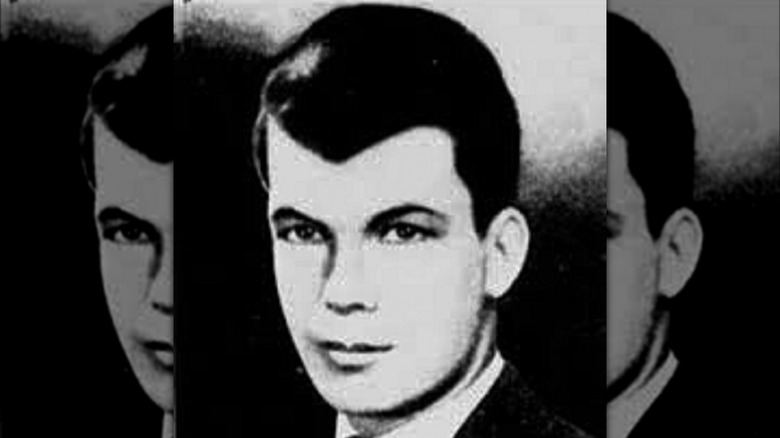The Creepy Story Behind Artemus Ogletree's Murder
The case of Artemus Ogletree still remains one of the most baffling mysteries to this day, and even with the pieces of evidence and accounts of those involved, people can only speculate on what really happened. On January 2, 1935, a young man who identified himself as Roland T. Owen checked into the Hotel President in Kansas. Employees at the hotel described him as well-dressed, and he looked to be in his 20s to early 30s. The bellboy, Randolph Propst, accompanied Owen to room 1046, and he observed that the guest didn't have luggage and only had a comb, brush, and toothpaste with him (via Medium).
That afternoon, hotel maid Mary Soptic was doing her housekeeping rounds. Upon entering 1046, the room was dimly-lit and Owen was inside. She continued cleaning the room, but before she finished, Owen left and asked her to keep the door unlocked when she was done, as he was expecting someone. Soptic described Owen as having a worried or scared look. Per Mental Floss, Soptic saw Owen again the following day when she cleaned the room. Again, the room was dark, and she overheard Owen speaking to someone on the phone and saying, "No, Don. I don't want to eat. I am not hungry. I just had breakfast. No. I am not hungry."
The events in room 1046
On the afternoon of January 3, Mary Soptic knocked on room 1046 to give the guest fresh towels. While waiting outside the door, she overheard two male voices. An unidentified male asked what she wanted, but didn't open the door. She said she was there to deliver towels, to which the voice answered, "We don't need any." Soptic found it odd, as she knew there weren't towels in the room, and she proceeded to knock on other doors, as reported by Medium.
On January 4, Hotel President's switchboard operator, Della Ferguson, noticed that the light for room 1046 was turned on, which indicated that the telephone was off the hook. She asked Randolph Propst to check what was going on, and when he got to the door of 1046, there was a "do not disturb" sign on the door. He knocked anyway, and a voice told him to enter. However, the door was locked, so he just asked the occupant through the door to hang up the phone (via Inside Mystery). An hour later, at about 8:30 a.m., the phone was still off the hook. A different bellboy was sent to 1046, and he used his key to get into the room. Inside, the room was dark and Owen was lying naked on the bed. He hung up the phone and left the room.
Again, at approximately 10:30 a.m., the phone was off the hook. Propst used a key to gain access into the room, and what met him was a grisly scene.
Roland T. Owen's death
Randolph Propst described the scene in a statement to the police. Roland T. Owen was down on his elbows and knees while holding his head. "I noticed blood on his head. I then turned the light on. I looked around and saw blood on the walls, on the bed, and in the bathroom," Propst explained, as reported by Penn State University. Owen was still alive, and Propst immediately called for help. When investigators came and asked the injured man who had been in the room with him, he answered, "Nobody" and explained that he fell against the tub. Owen was brought to the hospital where a doctor assessed his injuries.
On January 5, Owen died from his horrific injuries. He was found with his neck, ankles, and wrists tied, and he had a fracture to his skull. He also had multiple stab wounds on the chest, which punctured a lung. The bruises on his neck suggest that he was strangled. All these, the doctor concluded, were sustained approximately six to seven hours before he was discovered — right about the time when his hotel room phone was off the hook, per Medium. Since Owen claimed that nobody was in the room with him, detectives investigated a suicide angle. However, no weapons were found in his room, so that theory was quickly discarded. Furthermore, fingerprints belonging to a female were found on Owen's hotel room phone.
Roland T. Owen's real identity
Investigators discovered that the man who was killed wasn't really Roland T. Owen. The case made headlines, and many people who had missing loved ones checked to see if the mysterious man could be who they are looking for. A couple of months after the man's death, the case went cold, and he was yet to be identified. It was announced in the newspaper that he was to be buried in a pauper's grave, but the funeral home received a call from an unknown person who requested for the man not to be buried yet and said that funds would be sent for a proper funeral service, per Factschology. A few weeks later, the funeral home received the funds to cover a funeral along with a card that read, "Love for ever — Louise."
In 1936, Ruby Ogletree's friend saw a photo of Roland T. Owen in a magazine that featured his mysterious death. The friend showed Ogletree the photo, and she identified Owen as his son — 17-year-old Artemus Ogletree. He was identified with a scar on the left side of his head, as well as a cauliflower ear. In 1935 — after Artemus' death — Ruby started getting typewritten letters about her son's travels. She found it strange, however, as Artemus didn't know how to use a typewriter. Furthermore, the writing and words used didn't sound like her son's. She received several typewritten letters from Chicago, Europe, and New York, among other places (via Mental Floss).
Artemus Ogletree's death remains a mystery
Although the real identity of Artemus Ogletree had been revealed, the mystery of his murder was never solved. The person he talked to on the phone called Don was never identified, nor was the woman whose fingerprints were found on the phone in Ogletree's hotel room. The anonymous person who paid for Ogletree's funeral, and the note from Louise remain a mystery as well, as reported by Medium. Furthermore, in August 1935, Ruby Ogletree received a phone call where the caller said that her son had saved someone and had moved to Egypt where he married a rich lady.
Throughout the years, many theories have been put forward regarding Ogletree's death. Some say that the young man was involved in organized crime and owed money, while others say that he was killed by a jilted lover after breaking off their relationship. Investigators were never able to have an official suspect in the murder, and it seemed that discovering the real identity of the murdered man only raised more questions.




